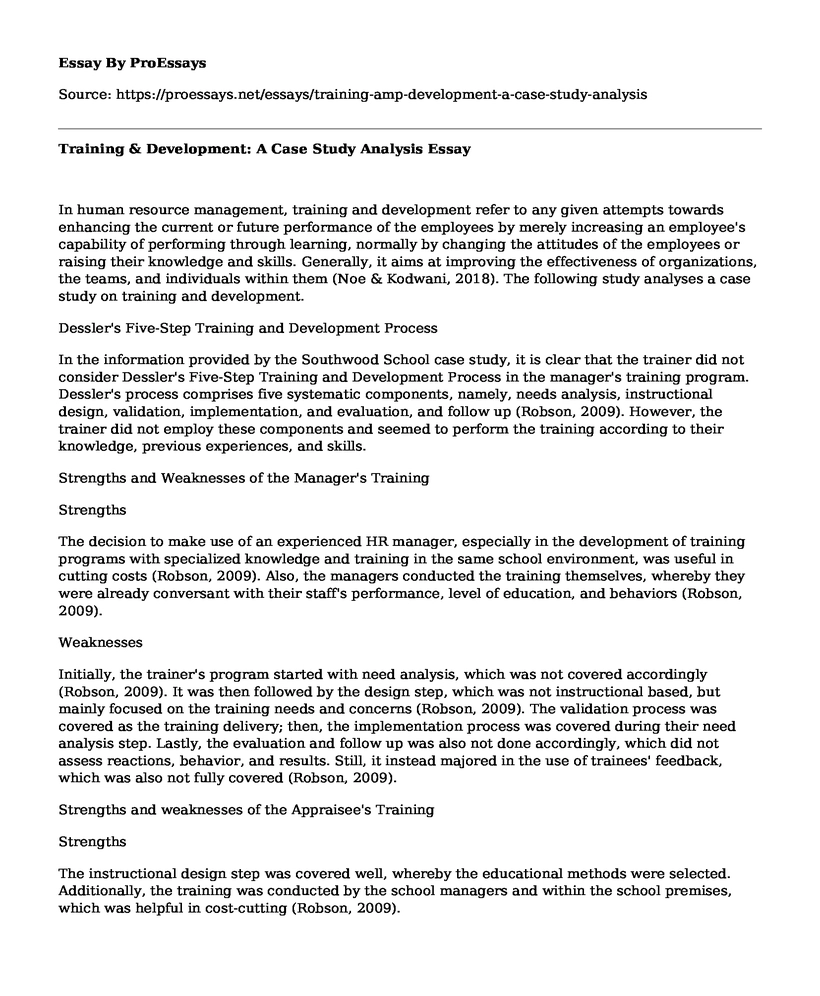In human resource management, training and development refer to any given attempts towards enhancing the current or future performance of the employees by merely increasing an employee's capability of performing through learning, normally by changing the attitudes of the employees or raising their knowledge and skills. Generally, it aims at improving the effectiveness of organizations, the teams, and individuals within them (Noe & Kodwani, 2018). The following study analyses a case study on training and development.
Dessler's Five-Step Training and Development Process
In the information provided by the Southwood School case study, it is clear that the trainer did not consider Dessler's Five-Step Training and Development Process in the manager's training program. Dessler's process comprises five systematic components, namely, needs analysis, instructional design, validation, implementation, and evaluation, and follow up (Robson, 2009). However, the trainer did not employ these components and seemed to perform the training according to their knowledge, previous experiences, and skills.
Strengths and Weaknesses of the Manager's Training
Strengths
The decision to make use of an experienced HR manager, especially in the development of training programs with specialized knowledge and training in the same school environment, was useful in cutting costs (Robson, 2009). Also, the managers conducted the training themselves, whereby they were already conversant with their staff's performance, level of education, and behaviors (Robson, 2009).
Weaknesses
Initially, the trainer's program started with need analysis, which was not covered accordingly (Robson, 2009). It was then followed by the design step, which was not instructional based, but mainly focused on the training needs and concerns (Robson, 2009). The validation process was covered as the training delivery; then, the implementation process was covered during their need analysis step. Lastly, the evaluation and follow up was also not done accordingly, which did not assess reactions, behavior, and results. Still, it instead majored in the use of trainees' feedback, which was also not fully covered (Robson, 2009).
Strengths and weaknesses of the Appraisee's Training
Strengths
The instructional design step was covered well, whereby the educational methods were selected. Additionally, the training was conducted by the school managers and within the school premises, which was helpful in cost-cutting (Robson, 2009).
Weaknesses
The training and development program did not systematically follow the five steps recommended (Robson, 2009). According to Robson (2009), the needs were analyzed through e-mails that were sent to all support staff, and unfortunately, only less than 10% responded to them. Validation was not done at all since the trainers believed that doing so would have led to intimidation to some participants (Robson, 2009). During the training, the trainer, unfortunately, ran out of time, and the participants did not submit any formal evaluations (Robson, 2009). The participant's needs were very different, and thus accommodating them within the stipulated two-hour session was difficult, and there was very little participation by the trainees.
How Could a New Program Be Designed to Address the Identified Weaknesses in Question Two?
The new program designed should be a systematic step by step process (Robson, 2009). It should start with need analysis, which involves the identification of specific job performance skills required for improvement of performance and productivity. It also consists in analyzing the audience to make sure that the program will suit their particular education levels, skills, experience, personal motivations, and attitudes. It also involves the use of research for the development of specific performance objectives and measurable knowledge (Robson, 2009). Secondly, it should be followed by instructional designing which comprises garnering instructional objectives, media, procedures, description of content sequence, exercises, activities, and examples; ensuring that all materials like leader's guides, video scripts as well as participant's workbooks are complementary to each other, are clearly written and are in alignment with the learning objectives stated. All the program elements should be professionally and carefully handled, whether reproduced on tape, paper, or film to guarantee effectiveness and quality(Robson, 2009).
Validation should be the third step, which includes the training introduction and validation before a representative audience (Robson, 2009). The final revisions should be based on pilot results to make sure that the program is effective. Implementation is the fourth step, which includes train-the-trainer workshops focusing on knowledge presentation, skills, and training content (Robson, 2009). Evaluation and follow up is the fifth step, which involves assessing the success of the program according to reaction, which is the documentation of the learners' immediate reactions basically to the training. It also includes learning, which is the use of pre-and posttests or feedback in measuring what the learners have learned. Another component of evaluation and follow up is behavior, which is the supervisor's observation and reactions to learner's performance after completing the training that is useful in measuring the learner's application degree to new knowledge and skills to their jobs. Finally, it involves results, which is the determination of improvement level within the job performance and assesses required maintenance(Robson, 2009).
References
Noe, R. A., & Kodwani, A. D. (2018). Employee Training and Development, 7e. McGraw-Hill Education.
Robson, F. L. (2009). Southwood school: A case study in training and development. Society for Human Resource Management (SHRM).
Cite this page
Training & Development: A Case Study Analysis. (2023, May 30). Retrieved from https://proessays.net/essays/training-amp-development-a-case-study-analysis
If you are the original author of this essay and no longer wish to have it published on the ProEssays website, please click below to request its removal:
- Effects of Consumer Preferences on Foreign Sourced Products
- Evaluation Essay on Amazon and Whole Foods Market, Inc.
- The Fair Labor Standards Act Essay Example
- Summary of the History Amazon - Essay Sample
- Essay Sample on Foreign Policy: Impact on International Trade and Harley-Davidson
- Successful MBEs and Accessing Capital for Growth and Sustainability - Essay Sample
- Essay Sample on International Activities: Essential for Firm Monopoly Advantage







